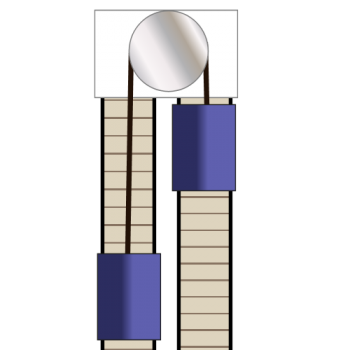Book Against Wall
Pro Problems > Physics > Motion and Forces > Linear Motion > Force > Friction > Static FrictionBook Against Wall
I am pushing a book (mass: 5 kg) against a vertical wall, and the coefficient of static friction between the book and the wall is 0.25. How hard do I need to push the book to keep it from moving?
Solution
In order to make it feasible for teachers to use these problems in their classwork, no solutions are publicly visible, so students cannot simply look up the answers. If you would like to view the solutions to these problems, you must have a Virtual Classroom subscription.Similar Problems
Funicular Railway

A funicular is a train with two cars attached by a rope/chain. The two train cars are on parallel tracks on the side of a mountain. While one car is at the top, the other is at the bottom. In order to reverse position, water is pumped into a tank in the car at the top until it is heavier than the car at the bottom. Then, when the brakes are released, the top car pulls the bottom car up as it goes down. Once they have reversed positions, the water is drained from the lower car's tank, and the process can be reversed.
There is a very small coefficient of rolling friction between each car and the track (0.0005). We will assume the system is otherwise frictionless.
Both cars have a mass of 50,000 kg. The car at the top of the mountain has 30 passengers, with an average mass of 75 kg. The bottom car has 25 passengers with an average mass of 80 kg.
If the slope of the track is 30 degrees, how much water will be needed in the top car to set the apparatus in motion?
The Grinch Goes Up Mount Crumpit
Down in Who-ville, no one knows that all their Christmas trees, presents, decorations and roast beasts have been stolen. Max, on the other hand, is perfectly aware of this. Not just because it all landed on him as he stood next to each home, but also because he now has the impossible job of dragging the entire sleighful of hot Christmas items back up the mountain.
We'll make the following assumptions: in each home the Grinch stole one Christmas tree (average weight: 50 pounds), one roast beast (25 pounds average), 20 Christmas gifts (average weight: 5 pounds), miscellaneous ornaments, food items, etc, weighing in at another 100 pounds. We'll also assume that the Grinch burgled 40 houses. The weight of the Grinch's sleigh is 550 pounds, and the Grinch himself is 300 pounds.
Finally, the angle of inclination of Mount Crumpit is a whopping 60º, and the coefficient of static friction between the sleigh and the snow is 0.1. How much force will it take to get that sleigh started up the mountain?

